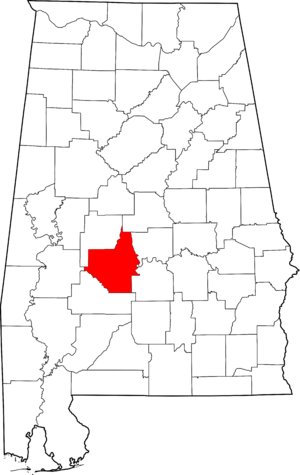National Register of Historic Places listings in Dallas County, Alabama facts for kids
Have you ever wondered about the old buildings and special places in your town or state? Many of these places are super important because they tell us about history! In Dallas County, Alabama, there are many such spots.
This article is about the amazing places in Dallas County that are listed on the National Register of Historic Places. This is like a special list kept by the United States government. When a place is on this list, it means it's really important for history, architecture, or culture. It helps protect these places for future generations.
Dallas County has 32 places on this list. Two of them are even more special! They are called National Historic Landmarks. This means they are super important to the history of the entire country.
Contents
Discovering History in Dallas County, Alabama
Dallas County is full of history, and many of its buildings and areas are recognized for their importance. Let's explore some of these cool places!
Important Landmarks in Selma
The city of Selma in Dallas County holds a very special place in American history, especially because of the Civil Rights Movement.
Places from the Civil Rights Movement
- Brown Chapel African Methodist Episcopal Church: This brick church was built in 1908. It's famous because it was a key meeting place during the Civil Rights Movement. Many important events, like the Selma to Montgomery marches, started here. It's a National Historic Landmark!
- First Baptist Church: This church, built in 1894, is another important spot for the Civil Rights Movement. It's known for its role in helping people organize and fight for equal rights.
- Edmund Pettus Bridge: This bridge crosses the Alabama River and is a National Historic Landmark. It's famous for being the starting point of the Selma to Montgomery marches in 1965. Brave people marched across this bridge to demand voting rights.
- Tabernacle Baptist Church: This church also played a big part in the Civil Rights Movement in Selma. It was a place where people gathered and planned for change.
Other Historic Buildings in Selma
- Joseph T. Smitherman Historic Building: This three-story brick building was built in 1847. It was first a school, then the county courthouse, and even a hospital! It shows the Greek Revival architecture style, which was popular a long time ago.
- John Tyler Morgan House: This historic house is another important building in Selma.
- Wesley Plattenburg House: This house on Washington Street is also recognized for its historical value.
- Marcus Meyer Skinner House: Located on Summerfield Road, this house is another Selma landmark.
- Sturdivant Hall: This beautiful mansion was finished in 1856. It's a great example of the Greek Revival style, designed by Thomas Helm Lee.
- U.S. Post Office Building: This building was completed in 1909 and designed by James Knox Taylor. It shows the Beaux-Arts architecture style, which is very grand and decorative.
Historic Districts in Selma
- Icehouse Historic District: This area in Selma is a historic district, meaning it has many old buildings that together tell a story about the past.
- Old Town Historic District: This is another large historic area in Selma, roughly near the Alabama River. It includes many old buildings that show how Selma used to look.
- Riverview Historic District: This district is also bounded by Selma Avenue and the Alabama River, preserving more of Selma's historic charm.
- Water Avenue Historic District: This district along Water Avenue also has many old buildings that show the history of Selma's riverfront.
Historic Churches and Buildings Across Dallas County
Dallas County has many other interesting historic places outside of Selma.
- Adams Grove Presbyterian Church: This wooden church was built in 1853 and is a beautiful example of Greek Revival architecture. It's located in Sardis.
- Antique Store (Plantersville): This old store in Plantersville is recognized for its historical value.
- Christian Church and Parsonage (Plantersville): Also in Plantersville, this church and its parsonage (the minister's house) are historic.
- Doctor's Office (Plantersville): An old doctor's office in Plantersville is also on the list.
- Driskell-Martin House (Plantersville): This house in Plantersville is another historic building.
- Todd House (Plantersville): Another historic house in Plantersville.
- J. Bruce Hain House: This house in Sardis is also a recognized historic place.
- Marshall's Grove: Located near Selma, this site is also historically important.
- Pleasant Hill Presbyterian Church: Built in 1851, this wooden church in Pleasant Hill is another example of Greek Revival style.
- St. Luke's Episcopal Church (Cahaba): This wooden church in Cahaba was built in 1854. It shows the Carpenter Gothic style, which uses wood to create a Gothic look.
- St. Paul's Episcopal Church (Selma): This brick church in Selma was built in 1875 in the Gothic Revival style, which looks like medieval cathedrals.
- Street Manual Training School: Located near Richmond and Minter, this school is recognized for its historical significance.
- Valley Creek Presbyterian Church: This brick church, built in 1857, is north of Selma in Valley Grande. It's another example of Greek Revival architecture.
Old Towns and Districts
Some entire towns or large areas are recognized for their history.
- Cahaba: This place, southwest of Selma, was actually the first permanent state capital of Alabama from 1820 to 1825! Today, it's a ghost town, but its ruins tell a fascinating story.
- Carlowville Historic District: This district south of Selma includes many historic buildings that make the whole area special.
- Summerfield District: This area in Summerfield is also a historic district, preserving the look and feel of an older time.
These places help us remember the past and understand how Dallas County and Alabama have changed over time. They are important parts of our shared history!
Images for kids































